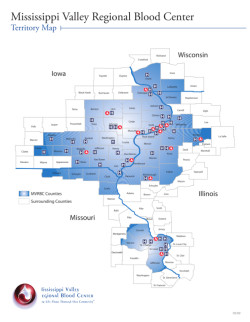 When he got started in blood banks almost 20 years ago, David R. Green's understanding of the blood-transfusion process wasn't very sophisticated. Green, now the president and CEO of the Mississippi Valley Regional Blood Center, had a background in finance.
When he got started in blood banks almost 20 years ago, David R. Green's understanding of the blood-transfusion process wasn't very sophisticated. Green, now the president and CEO of the Mississippi Valley Regional Blood Center, had a background in finance.
"I thought they simply took that bag of blood after they tested it and made sure that it was hanging above the patient, and it just flowed back in the patient," Green said last week. "I really didn't know."
Now Green runs an organization that last year collected more than 133,000 units of blood products, serves 53 hospitals in four states, and had more than $38 million in revenue in 2008. The organization's 72,000-square-foot building off 53rd Street in northeastern Davenport suggests a big operation, but few people realize just how large, or the complexity of the issues the blood-donation community deals with.
"The core of it is making sure the donors are safe, and that the product that goes out the back door is safe for recipients," said Dr. Louis Katz, the center's executive vice president for medical affairs.
The Mississippi Valley Regional Blood Center is trying to optimize - and therefore drive down - blood usage by hospitals; it is working to help identify heretofore poorly understood risks associated with blood transfusion; and Katz is among those preparing for the next disease threat to the blood supply. And the organization's size has the key benefit of keeping costs lower for local hospitals.
So it's not just bags of blood.
Less Is More
Because the blood center gets paid by hospitals only for blood products that are actually transfused, it's counterintuitive that the blood center is trying to get hospitals to lower usage.
There are two factors at work here: There is a limited supply of blood products available for transfusion, and there might be long-term adverse reactions to blood transfusion that have not yet been identified or are not yet fully understood.
"What that comes down to most recently is talking to clinicians about using less blood," Katz said.
The actual goal is optimization, which will result in lower blood usage. To that end, the Mississippi Valley Regional Blood Center began auditing its hospitals' transfusions last fall.
"If a hospital and their physician community are already at best practices, then no reduction in utilization happens," said Margaret M. Starkey, a utilization specialist with the center.
One study found that in the intensive-care unit, an effectively conservative approach to blood transfusion entails transfusing only when the hemoglobin drops below seven grams per deciliter. "Transfusing conservatively was at least equivalent in terms of clinical outcomes ... ," Katz said. "All the trends said conservative transfusion was better - safer."
Yet in an audit of one hospital's transfusion practices, 95 percent of ICU transfusions occurred above that level. "This hospital is not unique, by the way," Katz said.
There are no hard-and-fast rules for blood transfusions, and each medical situation must be considered individually, but Katz said a conservative approach would generally serve both patients and hospitals well. The hope is that presented with the transfusion patterns of their doctors and other facilities, hospitals would at least change the behavior of outliers - the doctors ordering transfusions most aggressively. "The blood center's job isn't just to be a dairy," Katz said. "It's to get information to the hospitals so that they understand what they need to do."
In most cases, Katz said, doctors who aggressively order transfusions are simply practicing medicine the way their were taught. "Habit's the biggest thing," Katz said. "It's how they were trained."
In other situations, he said, there might be good reasons doctors transfuse earlier than the guidelines suggest.
"The ultimate goal is to enhance patient safety," Starkey said. "Any time you have an invasive procedure, you have a risk."
She said earlier this month that 10 audits are in some stage of completion. While transfusion audits are not required or even common practice, she said, the Joint Commission - a private accrediting body for health-care organizations - is expected to set quality standards for transfusions in the coming years.
Another appeal of audits for hospitals served by the Mississippi Valley Regional Blood Center is that they spend less money on blood products. Because insurance companies generally pay a certain amount per procedure, using less blood during a procedure saves money.
"Cost containment really is a secondary gain," Starkey said. "Any time you avoid an unnecessary procedure, the patient's avoiding an unnecessary cost."
Reducing usage also has the benefit of ensuring that there's an adequate blood supply.
There's presently no shortage of blood, although the supply fluctuates seasonally. The 2007 National Blood Collection & Utilization Survey Report found that collected whole-blood and red-blood-cell units exceeded the number of transfused units by 7.8 percent. "These data, combined with the lowest rate of units outdated [past the date when they can be used] in recent years, suggest that hospitals and blood centers continue to improve efficiencies in delivering the appropriate product when needed," the report states. (Different blood products have different shelf lives. Whole blood, for example, expires after six weeks, while platelets last less than a week.)
And since this past winter, "the blood supply is actually quite flush ... ," Katz said.
But with the Baby Boomer generation getting older and living longer, there's likely to be a greater need for blood transfusions in the coming years and decades. "We feel we need to get into place the right processes to support that," Starkey said.
Katz added that it's also more difficult to get younger people to become donors. "It's much harder to get a Gen X or a Gen Y [person] ... into the blood center as a regular donor than it was my parents' generation," he said.
One challenge with blood donation is the number of "deferrals"; America's Blood Centers estimates that only 38 percent of people are eligible to donate blood. For example, men who have had sex with men since 1977 have a lifetime deferral. People who spent six months or more in the United Kingdom between 1980 and 1996 get a permanent deferral because of "mad cow disease." People with hemoglobin below a certain level get a temporary deferral.
Some deferrals meant to protect the blood supply are easily justified - there is no blood test for mad-cow disease, for instance - but others have been questioned. Since 1997, the American Association of Blood Banks has supported relaxing the male-to-male-sexual-contact deferral to one year. In a statement to the Food & Drug Administration in 2000, it said: "Modifying the deferral time period for male to male sexual contact to 12 months will make that deferral period consistent with the deferral period for other potentially high-risk sexual exposures and will improve the clarity and consistency of the donor screening questions. The potential donor will be directed to focus on recent, rather than remote risk behaviors and should have better recall for answers to the screening questions."
Because of the accuracy of HIV testing, Katz said, a one-year male-to-male-sexual-contact deferral would result in one transfusion-transmitted-HIV case every 17 to 58 years.
But the Food & Drug Administration hasn't relented. Its response, Katz said, is that "we cannot add risk to the system."
Biovigilance
Once it was identified and understood, HIV could be eliminated from the blood supply straightforwardly - through a test for antibodies.
 "We've picked the low-hanging fruit now," Katz said. "Since the onset of the HIV epidemic - that's 30 years - we've been consumed with transfusion-transmitted infectious diseases," including non-A/non-B hepatitis. Because the risk of transmitting those through blood donation has been nearly eradicated - there hasn't been a transfusion-related HIV infection in at least eight years, and the transmission risk is now estimated at less than one in 2 million, Katz said - the focus has now shifted to transfusion risks that are hard to pinpoint.
"We've picked the low-hanging fruit now," Katz said. "Since the onset of the HIV epidemic - that's 30 years - we've been consumed with transfusion-transmitted infectious diseases," including non-A/non-B hepatitis. Because the risk of transmitting those through blood donation has been nearly eradicated - there hasn't been a transfusion-related HIV infection in at least eight years, and the transmission risk is now estimated at less than one in 2 million, Katz said - the focus has now shifted to transfusion risks that are hard to pinpoint.
"We're beginning to ask questions about very difficult-to-measure adverse effects of blood and talking to physicians about using less," he said.
The U.S. Biovigilance Network (AABB.org/biovigilance) was formed in 2006, and Genesis Medical Center (through it relationship with Katz) is one of nine hospitals in a nationwide biovigilance pilot project underway this spring.
"Let's start counting cases" so priorities can be set, Katz said.
Katz said these negative effects might play out over weeks or months following the transfusion. "There are lots of studies that suggest that people who get more blood rather than less blood may have more infections acquired in the hospital, may have worse outcomes over the long run," he said. "There's a lot of discussion about whether blood transfusion alters the immune system or causes inflammation that could be causing long-term adverse outcomes."
Further complicating the issue is the fact that "these are people who are already sick. ... These are things that might happen to a sick person - sick enough to get transfusion - anyway. And so the relationship to transfusion is the critical issue."
By carefully tracking these events, the hope is that their relationship (if any) to transfusion can be identified, and the frequency will help hospitals and the blood-transfusion community determine which are the most important to address.
And while it's impossible at this point to know which of these suspected negative outcomes are serious problems, optimizing transfusion practices is the smart path. "We don't know how bad these other problems are," Katz said, "but we do know that an adverse event doesn't occur if you don't transfuse."
Anticipating the Next Threat
Even though HIV - through testing and donor screening - has been almost eliminated, infectious diseases could still pose a threat to the blood supply.
Katz and five colleagues in the American Association of Blood Banks' Transfusion-Transmitted Diseases Committee polled 20 members of the committee about the diseases they viewed as the next threat. Sixty-eight diseases "had at least a theoretical possibility of causing trouble in the blood supply now or someday," Katz said. So they prioritized them and assigned three or four to each committee member, who wrote a fact sheet describing the discrete characteristics of each.
"We're trying to be proactive," Katz said. "Instead of waiting for something to hit us, we're out there scouring the literature, reading the case reports, talking to regulators, talking to docs in Europe ... . We're trying to put stuff on the radar screen ... . We've been doing this reactive thing since HIV. ... Now we're trying to anticipate the problem."
Some diseases are not expected to threaten the safety of blood but still threaten the supply. There is minor concern about the transmission of the H1N1 (swine flu) virus through the blood supply, for example, but the larger concern would be a pandemic's effect on blood donation.
Katz is chair of the American Association of Blood Banks' Interorganizational Task Force on Pandemic Influenza & the Blood Supply, which is looking to get a specific exemption for blood donation from the U.S. Department of Health & Human Services' "social distancing" guidelines. In a presentation (HHS.gov/bloodsafety/presentations/DrKatz0806.pdf), Katz estimated donor absenteeism of 40 percent during a pandemic. If blood-donation sites take certain precautions, Katz said, blood donation should remain safe, even during a flu outbreak.
Size Matters
 These are some of the medical issues facing the Mississippi Valley Regional Blood Center, but the organization is also a fascinating business.
These are some of the medical issues facing the Mississippi Valley Regional Blood Center, but the organization is also a fascinating business.
It started in 1974 providing blood to Scott and Rock Island counties and now serves hospitals in northwestern Illinois, eastern Iowa, southwestern Wisconsin, and the St. Louis area. President/CEO Green said the organization has had a "visionary board," and that its original director saw what it could offer to other communities.
The expansion in 2005 to St. Louis created formal relationships in an area to which the blood center was already supplying a lot of product, and it gave it access to the donation program of a bankrupt blood bank that had been serving the metro area.
"It really gave us a volume opportunity," Green said.
The organization's growth has been conscientious, he added; the board will only expand into areas where there is not reliable service.
The blood center also has connections beyond its served hospitals. There's an emergency benefit there - "We have a network out there that is prepared to help us in a time of need," Green said - but also a financial one. "We have an established network throughout the United States such that we're able to provide those blood products to other communities that don't have as supportive a donor base as we do," Green said. "And historically, we have charged more for those products, and then that money comes back into this community and allows us to keep costs down ... ."
The aim is always to have more supply than demand, so that there's never a blood shortage at the hospitals served by the blood center. The surplus - roughly 35 percent a year, Green said - financially supports its core functions.
The center in 2004 moved to its current location, more than doubling its Locust Street facility's 30,000 square feet. And because the center was able to bring its nucleic acid testing back to the Quad Cities (instead of sending it to Minneapolis because of a lack of space), the larger building doesn't actually cost more. "The savings annually for bringing that back in house cover the carrying cost of the debt related to the facility," Green said. Including property and equipment, the center cost $14 million.
"We intentionally built larger than we needed at the time, but consistent with what we would expect based upon the growth that we had seen ... ," Green said.
The center provides payroll and accounting services for a Springfield, Illinois, blood-donation program, and donor infectious-disease testing for St. Luke's Blood Bank in Cedar Rapids.
That revenue, Green said, has helped to offset some price increases from the Mississippi Valley Regional Blood Center's vendors, although the organization has also had to eliminate some positions and nonessential functions.
"We are mindful of opportunities ... ," Green said.










